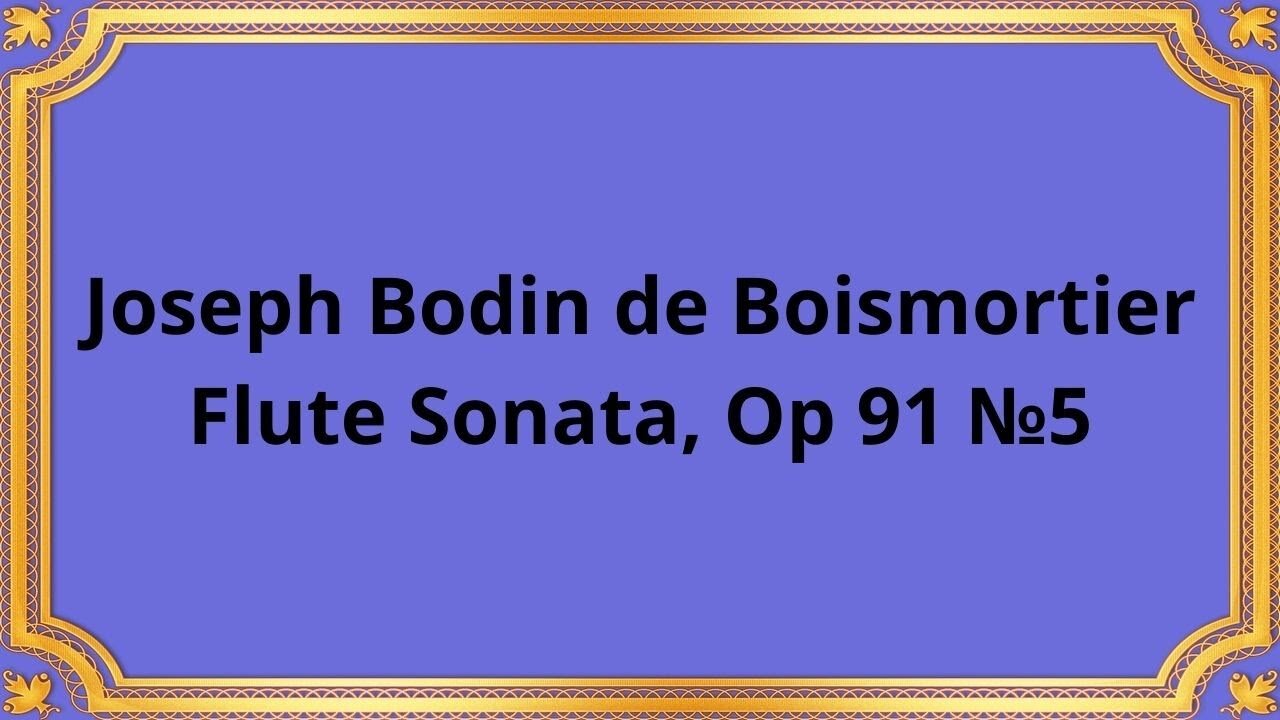Premium Only Content

Joseph Bodin de Boismortier Flute Sonata, Op 91 №5
#Boismortier #FluteSonata #ClassicalMusic #BaroqueComposer #MusicComposition #FluteMusic #ChamberMusic #BaroqueEra #FrenchComposer #Opus91
Rebecca Stuhr Rommereim, baroque flute
John Stuhr-Rommereim, harpsichord
"Joseph Bodin de Boismortier Flute Sonata, Op. 91 No. 5" is a significant piece of music composed by the French Baroque composer Joseph Bodin de Boismortier. Boismortier was a prolific composer, producing a vast body of work that includes chamber music, cantatas, and operas. The Flute Sonata, Op. 91 No. 5 is a prime example of Boismortier's contribution to the Baroque period.
The sonata is scored for flute and basso continuo, a common accompaniment in Baroque music consisting of a bass instrument such as cello or bassoon and a keyboard instrument such as harpsichord or organ. This particular composition showcases Boismortier's mastery of the flute as a solo instrument, highlighting its expressive capabilities and virtuosic potential.
The piece is structured in the traditional sonata form, typically consisting of three movements: fast-slow-fast. The first movement, often labeled "Allegro" or "Vivace," is characterized by its lively tempo and rhythmic drive. Boismortier's use of thematic development and contrapuntal techniques in this movement demonstrates his compositional prowess and mastery of Baroque style.
The second movement, usually marked "Adagio" or "Largo," contrasts the briskness of the first movement with a slower, more lyrical character. Here, Boismortier explores melodic richness and expressive ornamentation, allowing the flute to sing and emote within the framework of the basso continuo accompaniment.
The final movement, commonly designated "Allegro," "Presto," or "Allegro assai," returns to a brisk tempo, providing a lively and spirited conclusion to the sonata. Boismortier's dynamic use of rhythm and melodic interplay between the flute and basso continuo creates a compelling and exhilarating finale.
"Joseph Bodin de Boismortier Flute Sonata, Op. 91 No. 5" exemplifies the elegance and charm of the Baroque era, showcasing the interplay between the solo instrument and the accompanying basso continuo. Boismortier's keen understanding of the flute's capabilities and his adept compositional techniques make this sonata a timeless and cherished work within the flute repertoire, admired by performers and audiences alike.
You have the opportunity to support the channel:
https://destream.net/live/RadSiarAl/donate
https://www.buymeacoffee.com/6355radsiaral
-
 48:22
48:22
Classical music_Music Inspiration
1 month agoHector Berlioz Fantastic Symphony
791 -
 1:31:50
1:31:50
Russell Brand
2 hours ago“I’ll NEVER Be The Same…This SHOCKED Me” Dan Bongino Breaks Silence & Vows to Reveal “TRUTH” - SF621
123K72 -
 1:02:24
1:02:24
Sean Unpaved
2 hours agoGridiron to Diamond: Rookie QBs, Madden 99s, Salary Caps & NIL's Ripple Effect
18.4K -
 25:24
25:24
Scary Mysteries
6 hours agoSTRANGE & SCARY Mysteries of The Month - July 2025
3.44K -
 1:02:02
1:02:02
Timcast
3 hours agoTrump BULLIES Europe Into MONSTER Trade Deal, Europe COPING Over Trump MASTERCLASS
134K75 -
 2:07:13
2:07:13
Steven Crowder
5 hours ago🔴Game Over: Trump's EU Trade Victory Shows How Stupid "Experts" Really Are
366K189 -
 20:03
20:03
Neil McCoy-Ward
2 hours agoTHE UK 🇬🇧 JUST ENDED 140 YEARS OF FREE SPEECH! (How Did It Come To THIS?!)
13.2K10 -
 1:56:26
1:56:26
The Charlie Kirk Show
3 hours agoTHE CHARLIE KIRK SHOW IS LIVE 07.28.25
63.1K15 -
 5:39:28
5:39:28
JuicyJohns
6 hours ago🟢#1 REBIRTH PLAYER 10.2+ KD🟢 !loadout
69.7K1 -
 52:11
52:11
Anthony Pompliano
3 hours agoWhy Bitcoin Will EXPLODE During The AI Era
21.2K4